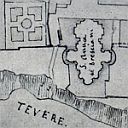0239 La chiesa dei Ss. Faustino e Giovita dei Bresciani a Roma
Identifiers (Article)
Identifiers (Files)
Abstract
The church of Ss. Faustino and Giovita in Rome was built by the Brescian confraternity in 1575, after they obtained the necessary papal permit for an intervention within the ruins of an unfinished palace of justice (palazzo dei Tribunali) by Donato Bramante. This space played an important role in Rome’s public life, as during the sixteenth century theatrical productions were staged within its walls and one of the first Tiber traghetto dockings was situated nearby. The Brescian community also established a national hospice within the ruins, which was demolished, together with their church, during the late nineteenth-century rebuilding of the Tiber banks. This paper investigates the notion of identity of the Brescian "Nation" (the city of Brescia being ruled by the Republic of Venice, which itself was represented in Rome through different buildings and institutions). It focuses on the activity of Carlo Fontana, the official architect of both the Serenissima and the Brescian confraternity, who designed the new façade of the church of Ss. Faustino and Giovita, as well as many new features of the Venetian embassy in Rome, now known as Palazzo Venezia. Fontana also designed projects in Brescia and neighbouring towns such as Bergamo and Como, as well as different projects in the Veneto, which will be explored here from a comparative perspective.
Statistics


License

This work is licensed under a Creative Commons Attribution-NonCommercial-NoDerivatives 4.0 International License.



